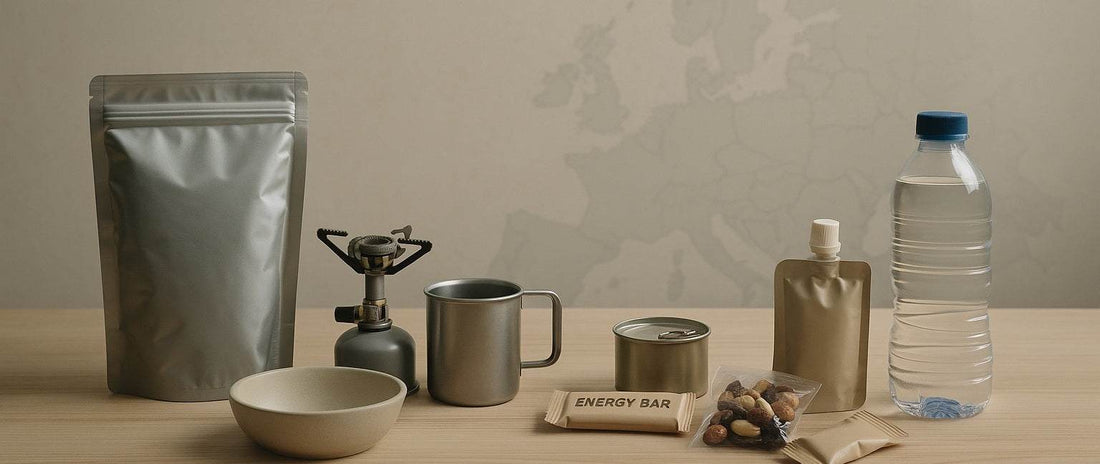
Top 10 Mistakes People Make When Preparing a 72-Hour Emergency Kit
Share
Preparing a 72-hour emergency kit has become a critical recommendation across the European Union, especially as civil preparedness gains new focus. But not all emergency bags are created equal — and many households unknowingly make serious mistakes when building theirs. Whether you're planning for power outages, natural disasters, or geopolitical disruptions, this guide highlights the most common pitfalls Europeans make when preparing a 72h survival kit, and how to build a reliable EU-compliant emergency bag that keeps you safe for the crucial first 72 hours of any crisis.
1. Underestimating Water Needs
Water is your first line of survival. EU guidelines recommend a minimum of 2 liters per person per day — that's 6 liters per adult for 72 hours, not including extra for hygiene. Yet many households fail to store enough drinkable water or means of purification. Always include sealed bottled water, water purification tablets, or a portable filtration system in your 72h emergency kit for Europe.
2. Choosing the Wrong Type of Food
A common mistake in DIY survival kits is relying on either perishable items or untested freeze-dried meals. In fact, many people report digestive problems or illness during emergencies due to unfamiliar dehydrated foods. Your 72-hour kit should include calorie-dense, non-perishable, and easy-to-digest items like energy bars, canned goods, dried fruits, and crackers. Think simple, nutritious, and familiar. Always test any survival food before an actual emergency.
3. No Backup Power or Lighting
When power goes out, light and communication become essential. A proper EU 72h survival bag should include: LED flashlights, spare batteries, a headlamp, and ideally a hand-crank or solar-powered radio. Add a reliable power bank to recharge your phone or radio when the grid is down. Emergency authorities in Europe stress the importance of staying informed through FM/AM radio updates.
4. Forgetting Document Protection
Your identity and health info are vital during evacuations. Still, most people overlook this. Your 72-hour emergency kit for Europe should contain waterproof copies of ID cards, medical records, insurance policies, prescriptions, and emergency contact lists. Use a fire- and water-resistant document bag to keep everything safe.
5. Skipping Medication and First Aid
Many survival kits fail to include critical prescription medications. Always prepare a 3-day supply of essential medicines per family member, along with copies of prescriptions. Also include a robust first aid kit: antiseptics, sterile dressings, scissors, pain relievers, and any medical supplies relevant to your household. These items can make a major difference in the first 72 hours of a crisis.
6. Poor Bag Choice or Overpacking
Some people use old gym bags or stuff their kits so full they can’t lift them. Your emergency bag should be durable, water-resistant, and easy to carry. Use a backpack with multiple compartments, padded straps, and a volume of at least 40–50L. Remember: a good emergency go-bag Europe must be mobile and organized.
7. Not Including Clothing or Shelter Items
In Europe’s variable climate, lack of appropriate clothing can lead to hypothermia — even indoors. Include thermal underwear, socks, gloves, and hats, as well as an emergency blanket or bivy sack. A compact tarp or foil tent also helps in case you must shelter outdoors. Always adapt your 72h kit to the season and region.
8. No Communication Plan or Paper Contacts
If your phone battery dies or the network fails, how will you reach loved ones? Include a printed contact sheet with numbers for family, neighbors, emergency services (112), and a designated out-of-town contact. This complements your emergency bag and strengthens your household’s 72h crisis resilience.
9. Failing to Maintain or Check the Kit
People often build their kit once and forget about it. Review your emergency kit every 6–12 months: check expiration dates, replace batteries, and update supplies for seasonal changes or family needs. Maintenance is part of preparedness.
10. Believing "It Won’t Happen Here"
Perhaps the most dangerous mistake in Europe today. Between cyberattacks, blackouts, floods, and geopolitical instability, crises can affect any EU member state. The European Commission urges all households to prepare for at least 72 hours of autonomy. Having a reliable EU-compliant 72h survival kit is not paranoia — it’s smart, civic responsibility.
Build Your Emergency Kit with Confidence
Instead of guessing what to include or risking a poorly equipped bag, many Europeans are choosing verified, ready-to-use kits designed around EU civil protection recommendations. Save time, avoid mistakes, and gain peace of mind.


